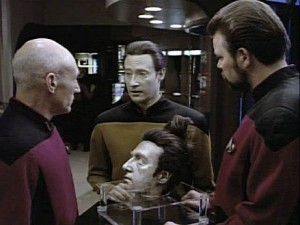
Popular film subjects reflect the spirit of the times, especially when it comes to genre movies. The radiation-themed horror movies of the 1950s were products of the Cold War. Disaster movies were big in the 1970s during the gas crisis, and they’re big again now with our concerns about the climate. The escapism of superhero movies over the past decade might have a lot to do with the recession.
What got me started thinking about this was my recent post about Ex Machina and how we relate to technology. It seems to be that machines are everywhere in movies and have been for decades, but the way we see them is changing. Computer and robotic technology has previously seemed sinister — think of HAL 9000 for one of the earliest and best examples — but in the more recent past, they’ve generally been helpful allies and friendly droids. The idea of an artificial or collective intelligence like the Borg in Star Trek, which is adaptable enough to outwit us and alien enough to harm us seems like an increasingly common thread in modern filmmaking.
Before I talk more about robots, I want to give a nod to the man who helped make them a staple in film and literature. Isaac Asimov invented the term “robotics” and the concept of the Three Laws of Robotics that govern robot behavior:
1. A robot may not endanger a human being, or through inaction, allow a human being to come to harm;
2. A robot must obey a human’s orders unless those orders conflict with the First Law;
3. A robot must protect itself unless those orders conflict with the First or Second Law.
Asimov wrote hundreds of stories exploring these laws, but he rarely wrote about machines that outright defied them. His ideas about the sophistication of robots’ positronic brains like the android, Data in Star Trek, were simpler in many ways than the average desktop computer. Our present is the science fiction Asimov tried to predict, and as good as he was, he didn’t foresee just how quick or smart artificial intelligence could become.
Ex Machina is a great example of how an AI might think. Manipulative and self-serving, Ava is the epitome of the dangerously capable machine. It’s impossible even to predict what she’ll do when she gets into the world and passes for human. What would she want being totally freed from human restrictions? In Her, the pain Theodore (Joaquin Phoenix) feels is emotional rather than physical, but it’s still the direct product of a machine that’s transcended any need for people. The Matrix trilogy left machines reliant on people, but as a source of energy, not as controllers or even allies.
Even in Wall-E, a movie that makes machines into heroes, the seemingly giving machines that let people turn into complacent blobs has a sinister autopilot behind them. It’s precisely because so much of our lives have become automated and simple, says this far-future science fantasy, that machines can harm us. Pixar’s team isn’t the only group to have reservations about artificial intelligence; Stephen Hawking and Bill Gates have expressed some unease over the possibility of an ungoverned AI. It’s a pretty unsettling threat, and that makes it a great subject for thought-provoking films.
About the author: Jonathan Roberts is an NYU Tisch student of cinematic and commercial filmmaking with a passion for storytelling.
FilmThat™ is a video production company founded and run by Jonathan Roberts. FilmThat.com™ explores the world of filmmaking and visual narrative. Favorite topics include impact driven screenwriting, producing, directing, shooting, and editing cinematic, corporate and documentary films.
All rights reserved © 2015 Jonathan Roberts
